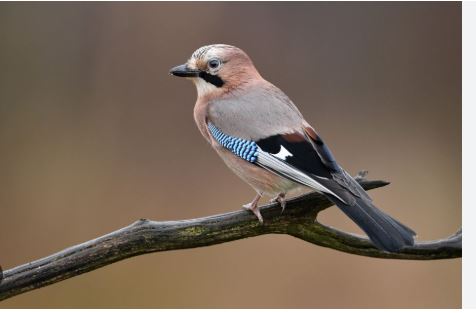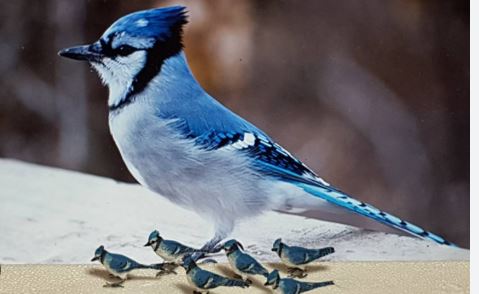
Jay birds captivate with their vibrant plumage, often showcasing striking shades of blue, green, or brown that shimmer in sunlight. Their feathers, ranging from glossy and iridescent to soft and muted, create a stunning visual contrast against forest canopies or suburban backyards. With sleek bodies and strong, pointed bills, these birds exude a bold, intelligent presence.
Their appearances vary widely, from crested heads to sleek, crestless forms, with some sporting intricate patterns like barred wings or contrasting facial markings. The vivid colors, particularly blues, are often caused by light scattering, giving their feathers a luminous quality. This diversity in plumage makes them a favorite among observers.
These birds thrive in diverse habitats, from dense coniferous forests and tropical woodlands to arid scrublands and urban parks. Their adaptability allows them to flourish across continents, blending seamlessly with foliage or standing out in open spaces. Their widespread presence enhances their appeal to nature enthusiasts.
Known for their social nature, jay birds often display expressive behaviors, accentuated by their bold colors and distinctive features like tufted crests or long tails. Their agile movements and sturdy builds reflect their intelligence, often seen in their clever foraging or caching habits. These traits add to their charismatic charm.

Types of Jay Birds
Common Blue Jay (Cyanocitta cristata)
The Blue Jay sports a striking blue crest, back, and wings, contrasted by a white chest, underparts, and a black U-shaped collar around its neck. Its 11–12-inch frame, with a 13–17-inch wingspan, and strong, straight black bill create a bold, elegant look. The blue feathers, created by light scattering, shimmer vibrantly, with white wingbars and black barring adding intricate patterns. Native Area: Eastern and central North America, from southern Canada to Florida and Texas, in deciduous and coniferous forests, suburbs, and parks.
Steller’s Jay (Cyanocitta stelleri)
The Steller’s Jay features a dark blue body with a blackish head and a prominent triangular crest. Its 12–13-inch frame and sturdy black bill give it a dramatic appearance, with lighter blue streaks or spots on the forehead in some populations. The rich blue wings and tail, with darker barring, contrast sharply with the dark head. Native Area: Western North America and Central America, from Alaska to Nicaragua, in pine-oak and coniferous forests.
Florida Scrub-Jay (Aphelocoma coerulescens)
The Florida Scrub-Jay has a soft blue head, wings, and back, paired with a pale gray or white belly and a grayish-brown back. Its 10–11-inch crestless frame and straight bill lend it a sleek, understated elegance. The blue plumage, though muted, glows in sunlight, creating a subtle yet striking effect. Native Area: Central Florida, in scrubby oak habitats and sandy ridges, an endemic and critically endangered species.
California Scrub-Jay (Aphelocoma californica)
The California Scrub-Jay boasts a vivid azure-blue head, wings, and back, with a white throat and grayish underparts. Its 11–12-inch frame, long tail, and broad, straight bill give it a lanky look. The blue plumage varies in intensity, with a faint blue collar adding contrast. Native Area: Western United States, from coastal California to Baja California, in shrubby areas, woodlands, and backyards.
Woodhouse’s Scrub-Jay (Aphelocoma woodhouseii)
The Woodhouse’s Scrub-Jay features a lighter blue head, wings, and back compared to its California counterpart, with a pale gray belly and a subtle blue collar. Its 11–12-inch frame and straight bill create a streamlined appearance, with the blue feathers appearing softer and less vibrant. Native Area: Interior western United States, from Nevada to Texas and Mexico, in oak-pine woodlands and scrublands.
Island Scrub-Jay (Aphelocoma insularis)
The Island Scrub-Jay is a robust bird with deep blue upperparts, a grayish-white throat, and a pale belly. Its 11–12-inch crestless frame and sturdy bill enhance its bold look, with richer blue plumage than other scrub-jays. The vibrant blue hues make it distinctive. Native Area: Santa Cruz Island off California’s coast, in scrubby coastal forests and oak woodlands, an endemic species.
Green Jay (Cyanocorax yncas)
The Green Jay, despite its name, features a striking blue head and throat, accented by a black mask and yellow markings around the eyes, with a vibrant green body. Its 10–12-inch frame and strong bill give it a tropical flair, with the blue head contrasting vividly with the green back and wings. Native Area: Southern Texas to Central America, in scrublands, tropical forests, and riverine woodlands.
Mexican Jay (Aphelocoma wollweberi)
The Mexican Jay sports a soft blue head, wings, and back, with a pale gray or white belly and a grayish-brown back. Its 11–12-inch crestless frame and straight bill give it a sleek, social appearance. The blue plumage, subtle yet vibrant in sunlight, complements its cooperative lifestyle. Native Area: Southwestern United States and Mexico, in oak-pine woodlands and mountainous forests.
Pinyon Jay (Gymnorhinus cyanocephalus)
The Pinyon Jay has a lighter blue body and a shorter tail, with a slate-blue head and wings that appear streamlined. Its 10–11-inch frame and sturdy, pointed beak are adapted for seed foraging. The uniform blue plumage, though less vivid, lends a subtle elegance. Native Area: Western United States, from Utah to Arizona, in pinyon pine forests and arid woodlands.
Azure Jay (Cyanocorax caeruleus)
The Azure Jay boasts a dark blue body with a black head and upper back, accented by a subtle crest that can be raised or lowered. Its 11–13-inch frame and strong, sharp beak give it a bold appearance, with the deep blue feathers shimmering in tropical light. Native Area: Brazil, Paraguay, and Argentina, in tropical rainforests and forest edges.
Canada Jay (Perisoreus canadensis)
The Canada Jay, also known as the Gray Jay, features a pale gray body with subtle bluish-gray wings and back, and a white face with a dark nape. Its 10–12-inch frame and short, stout bill give it a fluffy, approachable look, with the bluish tones adding a hint of color. Native Area: Boreal forests of Canada and northern United States, in coniferous woodlands.
Eurasian Jay (Garrulus glandarius)
The Eurasian Jay has a pinkish-brown body with a black facial mask and vibrant blue-and-black-barred wing patches. Its 13–15-inch frame and sturdy, straight beak give it a refined look, with the blue wing patches providing a striking contrast to the muted body. Native Area: Europe, Asia, and North Africa, in deciduous woodlands, forests, and gardens.
Bushy-crested Jay (Cyanocorax melanocyaneus)
The Bushy-crested Jay features a glossy black body with a vibrant blue back, wings, and bushy crest. Its 12–13-inch frame and strong bill give it a bold, tropical appearance, with the blue plumage shimmering vividly against the black feathers. Native Area: Central America, from Guatemala to Honduras, in humid forests and pine-oak woodlands.
White-tailed Jay (Cyanocorax mystacalis)
The White-tailed Jay sports a black head and upper body with bright blue wings, back, and a white-tipped tail. Its 13–14-inch frame and sturdy beak enhance its striking look, with the blue feathers contrasting sharply with the white tail and black face. Native Area: Western Ecuador and Peru, in dry forests, scrublands, and desert oases.
Siberian Jay (Perisoreus infaustus)
The Siberian Jay has a grayish-brown body with subtle bluish-gray wings and a rusty-orange tail patch. Its 10–11-inch frame and short, stout bill give it a soft, understated appearance, with the bluish wings adding a delicate touch of color. Native Area: Northern Europe and Asia, from Scandinavia to Siberia, in boreal coniferous forests.
Plush-crested Jay (Cyanocorax chrysops)
The Plush-crested Jay features a glossy black head and chest with a vibrant blue back, wings, and tail, accented by a distinctive, plush-like crest. Its 13–14-inch frame and strong, black bill give it a bold, elegant appearance, with the blue plumage shimmering vividly in sunlight and a white patch above the bill adding contrast. Native Area: South America, from Brazil to Argentina and Paraguay, in tropical forests, woodlands, and forest edges.
Curl-crested Jay (Cyanocorax cristatellus)
The Curl-crested Jay sports a striking black body with a deep blue back and wings, topped by a unique, curled crest that resembles a pompadour. Its 13–14-inch frame and sturdy bill enhance its dramatic look, with the blue feathers contrasting sharply with the black plumage, creating a vibrant, eye-catching effect. Native Area: Central South America, primarily Brazil, Bolivia, and Paraguay, in savannas, cerrado woodlands, and forest edges.
Black-collared Jay (Cyanocorax affinis)
The Black-collared Jay has a glossy green body with a black head and a distinctive black collar across the chest, accented by bright blue wings and back. Its 12–13-inch frame and strong bill give it a sleek, colorful appearance, with the blue and green plumage blending into a tropical shimmer. Native Area: Central and South America, from Colombia to Venezuela and northern Brazil, in humid forests and forest clearings.
Purplish-backed Jay (Cyanocorax beecheii)
The Purplish-backed Jay boasts a deep blue, almost purplish back and wings, paired with a black head and underparts. Its 13–14-inch frame and robust bill create a bold silhouette, with the purplish-blue plumage glowing richly against the dark feathers, giving it a regal appearance. Native Area: Northwestern Mexico, in dry forests, thorn scrub, and oak woodlands.
White-naped Jay (Cyanocorax cyanopogon)
The White-naped Jay features a black head and upper body with a bright blue back and wings, contrasted by a distinctive white patch on the nape. Its 12–13-inch frame and strong, black bill add to its striking look, with the blue feathers shimmering vibrantly against the white and black accents. Native Area: Eastern Brazil, in tropical forests, savannas, and caatinga woodlands.
Tufted Jay (Cyanocorax dickeyi)
The Tufted Jay sports a black head and chest with a bright blue back, wings, and tail, accented by a prominent, tufted crest and white facial patches. Its 13–14-inch frame and sturdy bill give it a bold, charismatic appearance, with the blue plumage contrasting vividly with the white and black markings. Native Area: Western Mexico, in highland pine-oak forests, an endemic and restricted-range species.